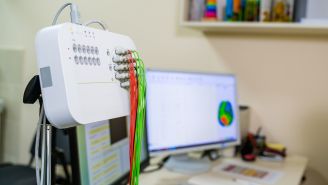Updated on July 25, 2024.
Photo credit: Anirudh Koul
It's been more than one year since Celine Dion revealed that she has stiff-person syndrome, and would need to cancel her Courage World Tour to focus on her health. Now, the 5-time Grammy award-winning singer is reportedly planning a comeback performance at the 2024 Paris Olympics.
Stiff-person syndrome is a rare neurological disorder. So rare, in fact, that many people may not have heard of it until Dion announced her diagnosis in December 2022 at the age of 54.
So, what is stiff-person syndrome, what does it do to the body—and can it be cured?
Stiff-person syndrome (SPS), also known as Moersch-Woltman syndrome, is a rare and incurable disorder that affects the central nervous system, or the brain and spinal cord. It affects only one to two people out of one million. In the U.S., it’s estimated there are fewer than 5,000 cases.
What happens to the body?
Initially, people with this condition develop stiffening in the muscles of their legs, back, chest, abdomen, and pelvis. This may come at go at first, but eventually the stiffness becomes constant. Over time—several months or up to a few years—it typically spreads to other muscles throughout the body, including the face and arms.
The severity of the disease and how quickly it progresses can vary from one person to the next. Some people may have changes to their posture and become hunched over and lose the ability to walk or move. They may eventually need to use a cane, walker, or wheelchair to get around and perform routine daily tasks.
Stiff-person syndrome can also trigger painful muscle spasms that last for a few seconds or up to a few hours. These episodes may occur suddenly without an apparent cause, or they may be triggered by noises, anxiety, or even a light touch.
Since stiff-person syndrome affects the ability to move and react, those affected at are greater risk for falls, broken bones, and other injuries.
People with the condition often experience anxiety and changes in mood. They may startle more easily to unexpected movements and develop a fear of crowded or public places. They may also have excessive or increased sweating.
Why do some people get it?
It’s not yet clear what causes stiff-person syndrome. Scientists are still working to understand why some people develop the disease. But research suggests it may be linked to an autoimmune response, in which the immune system attacks healthy cells.
Between 60 and 80 percent of people with stiff-person syndrome produce antibodies that destroy an enzyme known as glutamic acid decarboxylase (GAD). This enzyme is involved in the production of a neurotransmitter called gamma-aminobutyric acid (GABA) that helps control muscle movement.
There is also a link between stiff-person syndrome and endocrine disorders, particularly diabetes, which is likely related to the GAD antibodies.
Less commonly, some people with stiff-person syndrome have antibodies to a protein called amphiphysin that helps brain cells talk to each other.
Stiff-person syndrome is twice as common among women than men. It can develop at any age but most people who are diagnosed are between 30 and 60-years old.
Those with other autoimmune diseases, such as thyroiditis, vitiligo, and pernicious anemia, may be at higher risk for the condition. It’s also linked to certain cancers including breast, lung, kidney, thyroid, and colon cancers as well as Hodgkin’s lymphoma.
How do you know if you have it?
Symptoms of stiff-person syndrome may be confused with those of Parkinson’s disease, multiple sclerosis (MS), tetanus, myoclonic seizures, and fibromyalgia as well as anxiety and phobia, or intense fear or aversions of something.
The disease can be diagnosed, however, with the help of certain tests, including:
- Blood tests: This measures the level of GAD in the blood or helps detect antibodies to GAD or amphiphysin.
- Electromyography (EMG): This measures electrical activity in the muscles.
- Lumbar puncture (spinal tap): During this test, a needle is used to draw fluid from the spinal canal to check for antibodies to GAD.
These tests can also look for other signs that could point to —or rule out—other conditions.
Is it curable?
There is currently no cure for stiff-person syndrome but there are ways to help manage symptoms of the condition and help improve people’s quality of life.
Stiff-person syndrome is typically treated by a neurologist (a doctor who has special training in diseases that affect the brain and nervous system). Some people may also be treated by an endocrinologist (a doctor who has special training in diseases related to glands, hormones, and metabolism).
Therapies may include one or more of the following:
- Medications, such as benzodiazepines or baclofen to manage muscle stiffness and spasms. Anti-seizure drugs may also help ease pain or discomfort. Anti-anxiety drugs can help manage mood-related symptoms. Sometimes, anti-inflammatories and corticosteroids may also be used to manage flare-ups of the condition.
- Intravenous immunoglobulin (IVIG), a treatment for certain autoimmune related issues, may help prevent the body from attacking healthy cells and ease inflammation. There is some evidence this can help reduce muscle stiffness and ease sensitivity to noise, touch, and stress in those with stiff-person syndrome. For those who are resistant to IVIG, treatment options may include B-cell depletion (a treatment that targets cells called B cells that damage nerves in the brain and spinal cord), plasma exchange (a treatment that removes and replaces a patient's blood plasma), or drugs that suppress the immune system.
- Supportive treatment options may involve physical therapy, massage, water therapy, heat therapy, and acupuncture. Sleep may also help reduce muscle spasms related to stiff-person syndrome.







